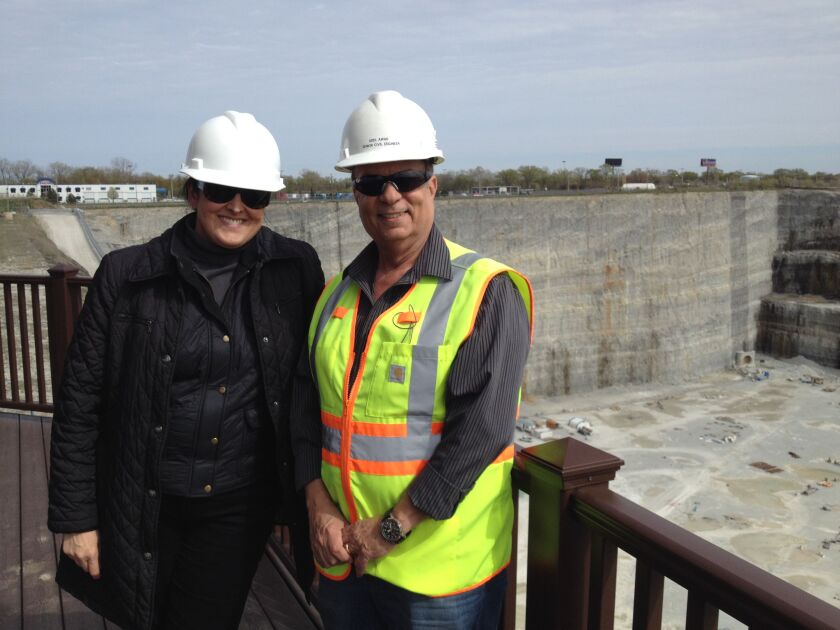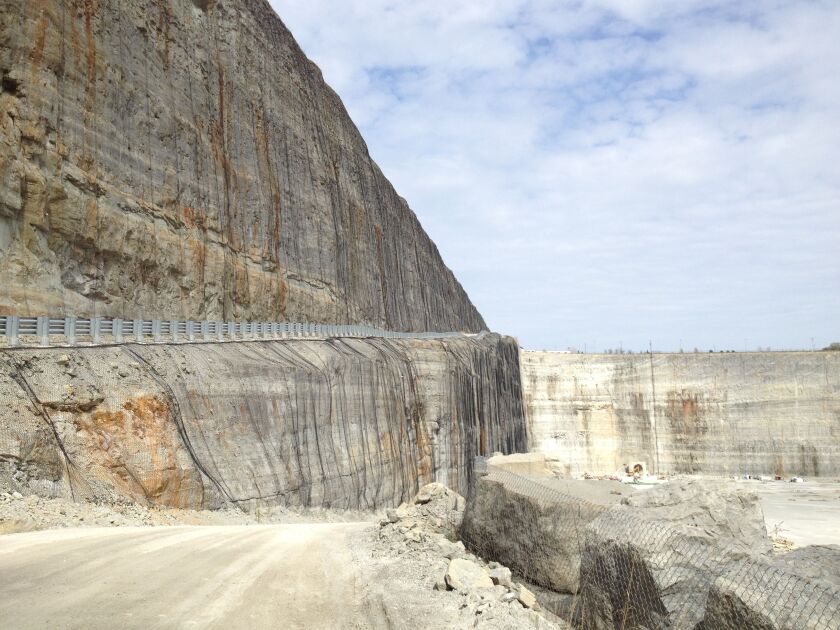When Brad Sutter was growing up nearby, of course he saw the Thornton Quarry. You can hardly miss it.
“I’ve driven past here hundreds and hundred of times,” said Sutter, of the series of vast limestone pits flanking Interstate 80/94 just south of Chicago. “As a child, you’re ‘Wow, it’s just so huge.’ In my mind it’s comparable to the Grand Canyon, though I’ve never seen it.”
So it was with great satisfaction that the 24-year-old’s first job for the Walsh Group was Safety Engineer, making sure that everybody who descends into the Grand Canyon of the Southern Suburbs comes back out again.
“Being able to go from seeing it my entire life, to work in it and make sure people go home to their families, it’s extremely rewarding,” he said.
So you need a hard hat — rocks tumble — and an M20 oxygen rescue pack, since there are massive tunnels to venture into. And neon yellow vests, to help prevent being driven over by heavy equipment. And the right boots, which nobody had mentioned beforehand. It didn’t matter that his guests included Mariyana T. Spyropoulos, president of the Metropolitan Water Reclamation District of Greater Chicago and Adel Awad, senior civil engineer for the MWRD, which for the past two years has been turning the north lobe of the Thornton Quarry into the Thornton Composite Reservoir. Sutter had us cool our heels until the proper footgear was sent down from the front office.
Mariyana T. Spyropoulos, president of the Metropolitan Water Reclamation District, and Adel Awad, senior civil engineer | Neil Steinberg/Sun-Times
“Just doing my job,” he said.
Not that I minded waiting at the bottom of this unimaginably huge manmade basin, 2,000 feet across, 1,000 feet wide and 300 feet deep, created over the past several decades by removing 76 million tons of limestone. Soon this tableau will be at least partially hidden under billions of gallons of water that would otherwise wind up in the basements of homes or in the Little Calumet River.
“This reservoir is going to protect 14 communities, about 500,000 people. Hopefully, it can save about $40 million in damages to the communities, annually,” Spyropoulos said.
Just having a big pit is not enough, however. It isn’t just a matter of hooking it up to the 109-mile Deep Tunnel network and turning a spigot. You have to prep: About $400 million worth of construction was needed to create the reservoir infrastructure. Limestone is porous, for instance, and the polluted storm and waste water would leach back into the water table if the reservoir weren’t sealed like a shower stall.
“The challenge here, you have to grout the four boundaries, to create a kind of wall, a curtain,” said Awad.
That was done by digging holes, hundreds of feet deep, every 20 feet or so around the perimeter and filling them with grout.
How much grout?
“A lot,” said Awad. Think a tube 6 inches wide and 150 miles long. “That spreads and forms a barrier.”
Controlling the force of the incoming water is another challenge. Inside the intake tunnel will be four enormous steel gates, two feet thick, costing $7 million each, moving on bearings the size of garbage-can lids. The 30-foot-wide intake tunnel is divided into two channels, to reduce the water’s force, and outside there is what amounts to a blast plate, designed to deflect the force of the flow and keep it from chewing up the reservoir bottom.
“During a storm, when the flow come through the tunnel, it’s huge force,” said Awad. “You need the structure to be stable. This concrete slab will be 6-feet thick; it will diffuse the energy.”
The water will only be held temporarily at the reservoir; it’ll flow by gravity to the Calumet Treatment Plant. Last year, the MWRD extracted 200,000 tons of what it tastefully calls “biosolids” — fertilizer that ends up on park district golf courses and athletic fields.
Back at the office, since one doesn’t often get the chance, I phoned Hanson Material Services, which bought the quarry a few years back, to ask about gravel.
Thornton Quarry | Neil Steinberg/Sun-Times
“Our biggest customers are concrete and asphalt producers,” said Bob Sapp, the quarry’s plant superintendent, who has worked there 27 years. “We’re continuing to mine it, and have many years of reserves left.”
I wondered what is the most interesting part of mining gravel.
“What we’re mining is 420 million years old,” he said. “This used to be an old coral reef. We find fossils of sea life.”
You can see the layers of rock formed over the millennia. For now.
“We’re hoping that this summer that we’re going to get water in here,” Spyropoulos said.
Until the water starts flowing, however, the MWRD is taking groups to see the dry reservoir. Various delegations from neighboring communities have visited, and Spyropoulos said that if interested groups contact her office, it will arrange a tour. I carefully explained, several times, that if you put a thing like that in the paper, people will actually do it. But she insisted that’s OK. So for next month or so, now’s your chance. Because it’ll be under water a long, long time. Though if you do go, a word of advice: Bring sturdy boots. Because Brad Sutter won’t let you in otherwise.
To schedule a tour, contact the MWRD Office of Public Affairs at tours@mwrd.org or phone 312-751-6633.







